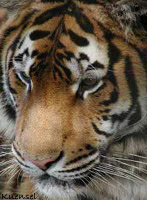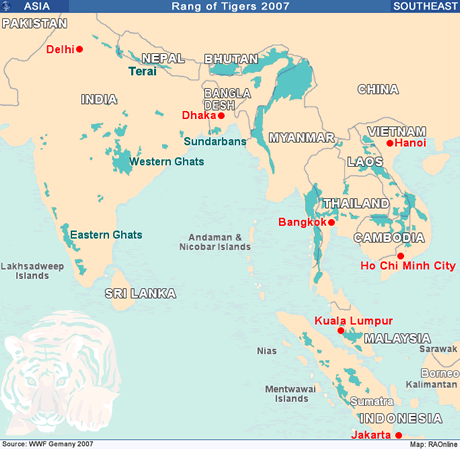| Bhutan's
Nature - Animals |
 |
Bhutan Nature Animals |
|
 |
Bhutan Information |
|
|
 |
| Securing
a future for Tigers |
 |
 |
| sub-tropical Royal Bengal Tiger |
| Even
as conservationists struggle to save the dwindling population of wild tigers
on earth, Bhutan was becoming a model for other countries to emulate say
world tiger experts. "Bhutan is not only a friendly home of tigers but
its tiger conservation is a model programme for the world," said Tiger
expert and chairman of Save the Tiger Fund, Mr. John Seidensticker. Mr.
John Seidensticker was among the 23 conservation scientists and tiger experts
from the United States, the United Kingdom, Norway, Germany and India who
met in Paro from September 13-16 along with Bhutanese officials and experts
to prepare the second Tiger Action Plan for conserving tigers in the country. |
|
The
Tiger Action Plan 2005-2015 will be the guiding document for all tiger
conservation efforts in future in Bhutan.
The
four-day conference took stock of the previous tiger plan and inputs from
conservation scientists and tiger experts were sought to address the biological,
ecological, social and economic aspects of tiger conservation, evaluation
and monitoring plans, to frame a comprehensive "middle path" strategy.
top
| Solutions
to the problem |
 |
 |
| Killing
the boar and protecting the livestock were the best solution to dealing
with the wild boar and wild dog problem according to a participant at the
tiger conference, Dr. A.J.T.Johnsingh the dean and faculty of wildlife
sciences of Wildlife Institute of India, in Dehradun. Dr. Johnsingh, who
has done extensive research on wild dogs and wild boars saidl that
there were about 11 subspecies of wild dogs, four of which were in the
Indian subcontinent. Of the four subspecies, two subspecies possibly lived
in Bhutan - one along the southern and middle hills and the other in the
upper regions of places like in the Jigme Dorji National Park.
|
|
"Bhutan
with almost 70 percent of forest cover and with the species like Sambar,
wildboar, barking deer, and the practice of letting cattle free in the
forest, was a great place for wild dogs," he said. To control the crop
losses to boars the most effective way, he said, was to encourage farmers
to kill boars within the fields as much as possible by shooting and setting
traps and nooses. "That will not deplete wild pig population because they
are prolific breeders and omnivorous eating just about every plant and
root." He also said that Bhutan could start an eco-tourism programme with
boar hunting near the farm fields as an attraction.
Dr.
Johnsingh said that to minimise the loss of livestock to wild dogs, farmers
should not leave their cattle and horses for long in the forest which was
the main cause for the wild dog attack. "They should take the cattle to
the forest and bring them back in the evening." A study found out that
in Thinleygang, in Emyu village, villagers did not lose much livestock
to predators because they did not leave livestock in the forest.
According
to conservation scientists the first Bhutan tiger action plan published
in 1998 was a model for the rest of Asia. "The plan will ensure the sustainability
of tiger population in the country," said the joint director of the Nature
Conservation Division, Dr. Sangay Wangchuk, which organised the conference.
Tiger
expert Mr. John Seidensticker told Kuensel that the task of saving tigers
or any other endangered species was never done because conditions changed
and being able to adapt conservation strategies with the changing conditions
was a challenge. "Tigers in Bhutan are not in a difficult situation as
in other places," Mr. Seidensticker said. "That creates an enormous potential
for conservation. About 50 percent of Bhutan's area has potential tiger
habitat. And that gives a good foothold for tigers."
For
Tigers to survive, he said, they must be managed at a landscape scale and
must include core areas like national parks, biological corridors and other
reserves for protection where tigers and their prey were fully protected.
That was the ecological approach to conserving tigers and Bhutan was doing
all that effectively, he said. In addition, he said, Bhutan had a strong
national forest and wildlife protection law that provided for the conservation
and protection of both habitat and endangered species. "I believe no one
is doing better than Bhutan. I don't think that many places have much to
teach Bhutan about large carnivore conservation."
Mr.
John Seidensticker said that Bhutan's tiger landscape today ranked as one
of Asia's most significant and anchors which could become one of the world's
largest tiger landscape. However there were many challenges ahead, the
biggest one being the human wildlife conflict, said the expert. "Securing
a future for tigers is impossible without the support of the people. Our
strategies needs how best to address that problem," said Mr. Seidensticker.
In
that context Bhutan's tiger compensation programme was a good start but
it had to be a continuous learning process and should adapt to changing
conditions. "The best way to make the compensation programme effective
is to let people know about the programme- to let them know that they are
not alone in their loss and that other people do care and want to help,"
said Mr. Seidensticker. Compensation claims should be quickly established
and money dibursed as soon as possible. That was the key to the success
of the programme, he said.
"Tiger
conservation goes to the heart of conservation," said Mr. Seidensticker.
Quoting an American conservationist, he added: "If we save the tigers,
we get to keep the planet."
| Contributed
by Kencho Wangdi, KUENSEL,
Bhutan's National Newspaper 2006 |
 |
top
| Wildlife and People in Bhutan |
 |
| Information on Bhutan |
 |
| Links |
 |
 |
 |
External
links |
|
|




